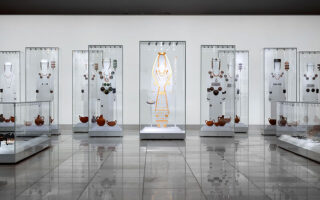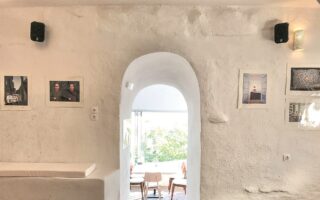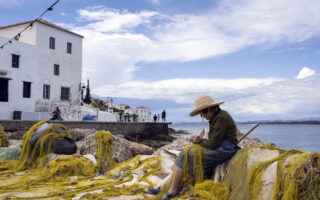10+1 best under-the-radar museums in Greece
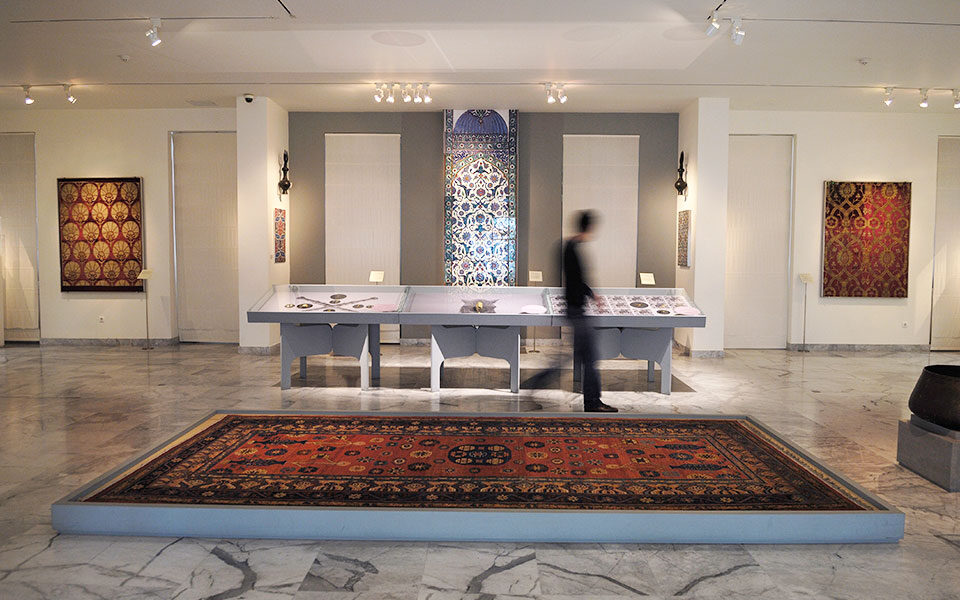
Greece is blessed with many things: sun, sea, beautiful islands, mountains, delicious cuisine, the list go on. And for all of you culture vultures out there, Greece has got more museums and archaeological sites than you can shake a stick at.
This is by no means an exhaustive list, but it covers many of the more popular islands and four locations on the mainland.
NOESIS – Thessaloniki Science Center and Technology Museum
Located near Thermi, on the outskirts of Thessaloniki, the NOESIS Center is a feast for the senses, ideal for families with young children. The state-of-the-art complex features a digital planetarium, a 300-seat Cosmotheater 3D (with the largest flat screen in Greece), and a motion “Simulator” theater, where visitors can enjoy immersive audiovisual extravaganzas that explore everything from the depths of the ocean to the surface of the Moon. The on-site Museum of Technology includes three permanent exhibitions: ancient Greek technology, classic cars, and an interactive technopark that presents a range of scientific topics such as electricity, magnetism, and optics through creative play. The Museum also hosts a series of rolling temporary exhibitions.
Fun, interactive and highly educational, NOESIS is an absolute blast for kids. Easily reached by bus from downtown Thessaloniki, it is an excellent option for when the weather is bad.
NOESIS is open to the public from Tuesday to Sunday. A daily family ticket (4 members) is 35 euros.
6th km Thessaloniki-Thermi, 570 01. Tel. (+30) 2310.483.000
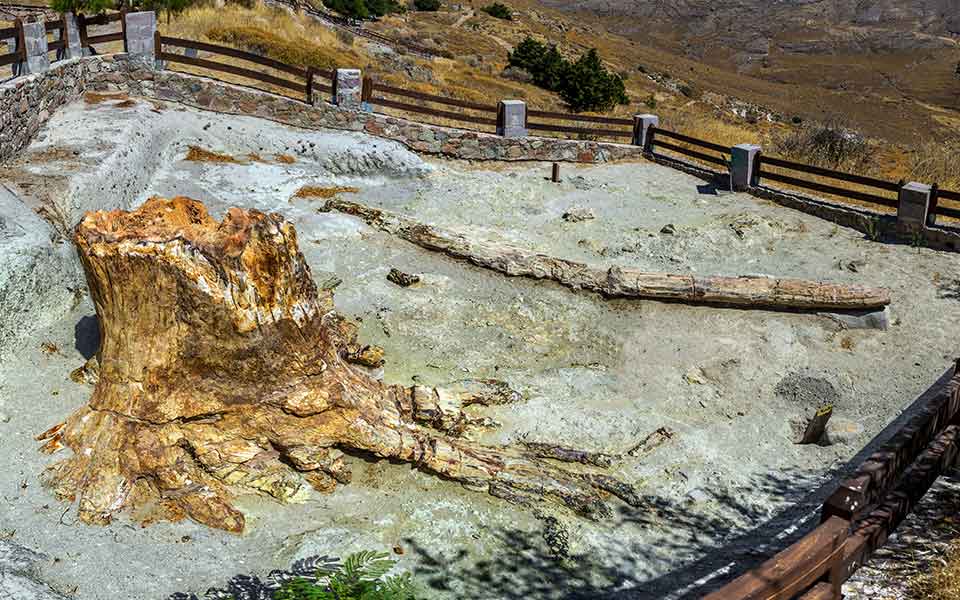
Natural History Museum of the Lesvos Petrified Forest, Lesvos
This absolute gem of a museum on Lesvos is the ideal place to discover the uniquely fascinating geological history of the Aegean. Located in the village of Sigri, near the western tip of the island, the Museum features a range of exhibits from the world-renowned Petrified Forest of Lesvos, a protected natural monument and member of UNESCO’s Global Geoparks network. Among the star attractions are fossilized trunks of giant sequoia trees – the biggest trees on Earth – and the bones of a Deinotherium, an enormous elephant-like animal, providing a fascinating snapshot of the subtropical ecosystem that once existed in the region during the early Miocene epoch, 20 million years ago.
The Museum also features an impressive exhibit on Theophrastus of Eressos, who was born in the area of the Petrified Forest around 371 BC. Theophrastus was among the first ancient Greek philosophers to consider fossils and the study of paleontology, and is widely regarded as the founding father of botany, ecology, and minerology.
The Museum, in collaboration with Levsos Petrified Forest Parks, offers a range of interactive activities for visitors throughout the year, including guided walking tours, a boat trip around the Nissopi Marine Park, and birdwatching excursions.
The Museum is open from Tuesday to Sunday. General admission is 5 euros per person.
Sigri, Lesvos, 811 03. Tel. (+30) 22530.544.34
Samos Archaeological Museum, Samos
Located in Vathi, the island’s capital, the Samos Archaeological Museum is spread across two sites: a beautiful neoclassical building from 1912, and a more modern wing, constructed in 1987. Packed to the gills with archaeological treasures from site excavations across the island, one of the most impressive exhibits is a gigantic marble kouros (young male) statue, standing over five meters tall. Dated to the 6th century BC, archaeologists attribute the statue to a local Samian artist who dedicated it to the Heraion, a large sanctuary to the goddess Hera, home the largest temple in the ancient Greek world, the so-called Polycrates Temple or “Great Temple.” The Heraion was designated a UNESCO World Heritage Site in 1992, along with the nearby archaeological site of Pythagoreion.
The Samos Archaeological Museum boasts one of the finest collections of Archaic statuary and sculpture in Greece. A bonus is that it is almost always deserted.
Open from Tuesday to Sunday. Full admission is 3 euros.
Vathi, Samos 831 00. Tel. (+30) 22730.274.69
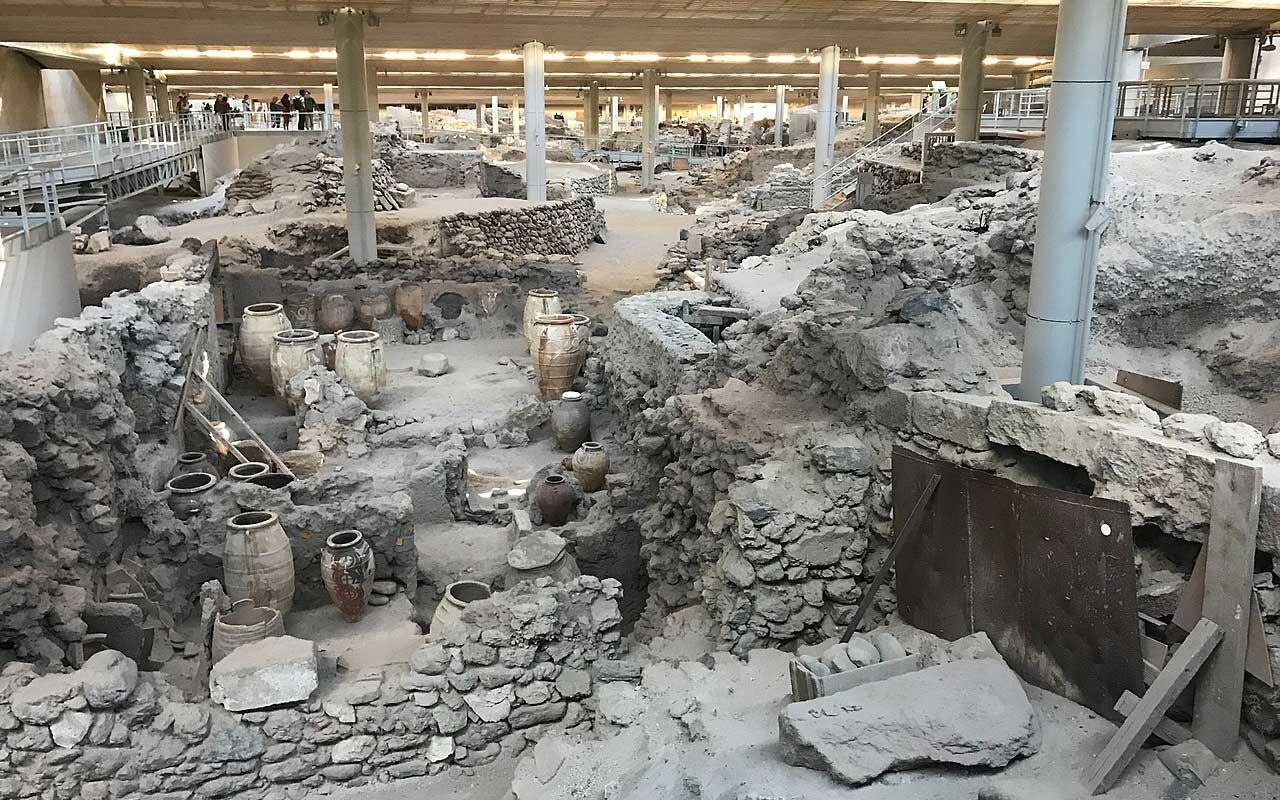
Museum of Prehistoric Thera, Santorini
The prehistoric settlement of Akrotiri is one of the most impressive and well-preserved archaeological sites in the world. Dubbed the “Pompeii of the Aegean,” it was destroyed in the Theran eruption sometime in the 16th century BC, buried under thick layers of volcanic ash. Frozen in time, the remains of buildings, household items, pottery, jewelry, and colorful wall frescoes provide an extraordinary snapshot into the everyday lives of the inhabitants, some 3,600 years ago. The Museum of Prehistoric Thera, located in the island’s capital, Fira, is housed in a modern two-story building, the brainchild of Greek archaeologist Spyridon Marinatos, the man who led the excavations at Akrotiri.
The Museum features four permanent exhibitions that cover all aspects of the island’s prehistoric past, from the arrival of the first settlers in the Neolithic to its heyday in the Middle to Late Bronze Age (18th and 17th centuries BC). It is best experienced after a visit to the site itself, where the collections can be put into context.
A special ticket package of 15 euros (valid for three days) covers the Museum and entrance to the archaeological site of Akrotiri.
Fira, Santorini 847 00. Tel. (+30) 22860.232.17
Aegean Maritime Museum, Mykonos
Amid all the glitz and glamor, is easy to forget that Mykonos was once home to a large mercantile fleet that plied the sea routes of the Mediterranean, engaging most of the island’s population in shipbuilding, seafaring, and trade. Founded in 1985, the Aegean Maritime Museum is a non-profit institution that seeks to promote Greek maritime history and tradition, with particular focus on the island’s mercantile activities following the 1821 War of Independence to the mid-20th century.
Housed in a traditional 19th century building, once the home of Nikolaos Sourmelis, Master of the merchant ship “Enosis,” the Museum is chocked full of nautical charts, paintings, historic photographs, and scale models. Best of all, one of the last genuine “Perama-type” broad-bottom merchant ships, the “Evangelistria,” is moored in the Old Harbor, a five-minute walk away from the Museum.
The Museum is open from April to the of October, Monday to Sunday. Ticket price is 4 euros.
10 Enoplon Dynameon, Mykonos 846 00. Tel. (+30) 22890.227.00
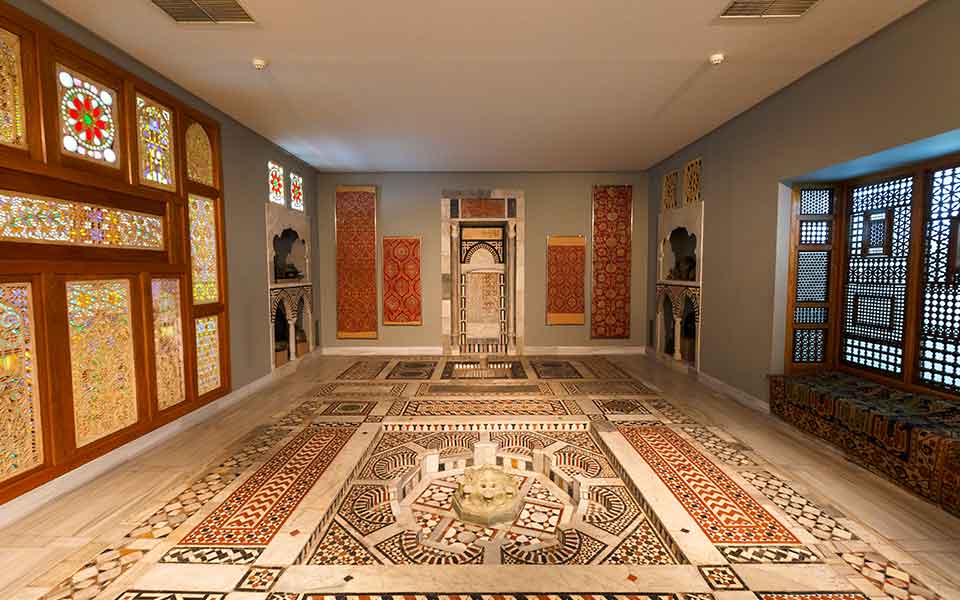
Benaki Museum of Islamic Art, Athens
The Greek capital is awash with museums, it’s sometimes difficult to know where to start. But if you’re seeking some quiet time away from the hustle and bustle, a trip to the Benaki Museum of Islamic Art in the downtown neighborhood of Thiseio is definitely the way to go. Packed with beautiful artifacts from the period of Ottoman rule in Greece, as well as other objects from the wider Islamic world, one of the stand-out exhibits is a reconstructed reception room from a 17th-century Cairo mansion, complete with ornate marble-faced walls and indoor floor fountains. Brightly colored artworks with exquisitely detailed floral motifs adorn the galleries, alongside decorative architectural features, textiles, ceramics, and weaponry.
A trip upstairs to the Museum café is an absolute must. Boasting some of the best views of the Acropolis, the ancient Agora, and the nearby Athens Observatory, it’s hands-down one of the city’s best-kept secrets. Shhhh.
Open Thursdays through Sundays, full admission is 9 euros.
22 Ag. Asomaton & 12 Dipilou, Athens 105 53. Tel. (+30) 210.3671.081
Museum of Palaiopolis – Mon Repos, Corfu
The summer residence of the former Greek royal family from 1864 to the 1967, and the birthplace of Prince Philip, Duke of Edinburgh, the Regency-style neoclassical mansion now houses a small but interesting museum featuring antiquities from the nearby archaeological site of Palaiopolis, the ancient city of Corfu. Located a short distance south of island’s capital, the Museum is surrounded by picturesque gardens, notable for its many exotic species of plants. The exhibition space on the ground floor presents historical photographs and various memorabilia from the time of the British protectorate on the island in the 19th century, the United States of the Ionian Islands, and offers a fascinating snapshot into the lives of the former Greek royals. The first floor displays exhibits related to the sites and sanctuaries of ancient Corcyra.
Further south is the Achilleion Palace, built in the late 19th century for the Empress Elisabeth of Austria, popularly known as “Sisi.” The stunning neoclassical building, surrounded by well-kept gardens and sculptures inspired by Greek mythology, later functioned as a casino, featuring in the 1981 James Bond film “For Your Eyes Only.” Open to the public, the site now functions as a museum.
The Museum of Palaiopolis – Mon Repos is open all week except Tuesdays. The price of admission is 4 euros.
Mon Repos Estate, Corfu 491 31. Tel. (+30) 26610.413.69
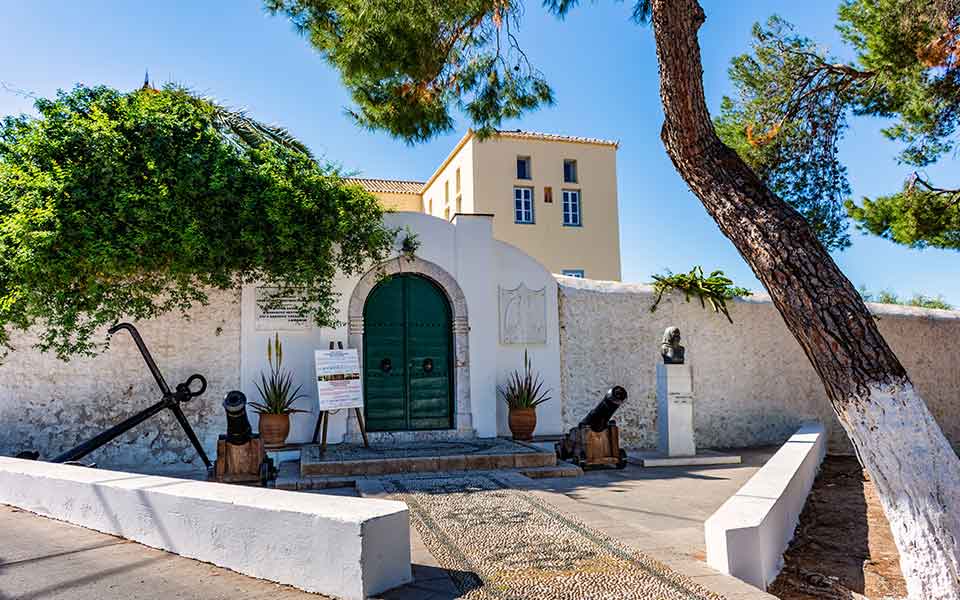
Bouboulina Museum, Spetses
A stone’s throw from Athens (relatively speaking), historic Spetses can easily be enjoyed as a day trip. A favorite hangout for artists and writers in more recent times, this tiny Argosaronic island played a crucial role in the Greek Revolution of 1821, being the home of the legendary freedom fighter and Greek naval commander, Laskarina Bouboulina (1771-1825). Founded in 1991 by a descendant of the great woman herself, the 350-year-old family mansion now functions as a cultural center, exhibiting a fine collection of personal items, including documents and letters, maps, antique books, and embroidery, alongside collections of weapons, Byzantine icons, Ottoman carpets, and European furniture from the 17th to the 20th century.
The highlight is the grand salon, with its beautifully carved Florentine ceiling. Bouboulina’s gold-plated pistol, used in countless engagements during Greece’s struggle for independence, hangs on the wall.
Dapia, Spetses 180 50. Tel. (+30) 22980.720.77
Museum of Cretan Ethnology
Located in the village of Voroi in southern Crete, just a few kilometers from the archaeological site of Phaistos, this award-winning museum brilliantly shows off what life was like for the rural inhabitants of the island in the medieval and early modern periods (from c. 1000 AD). It is especially rich in exhibits related to domestic life, agriculture, pottery, basketry and traditional music, its walls hung with graceful lyras and other musical instruments.
Since its formal opening in 1973, the Museum has developed into important ethnological research center, and regularly hosts educational workshops and conferences. The Museum is neatly divided into seven thematic sections, each devoted to human society’s fundamental modes of survival and successful adaptation: food, architecture, handicrafts, production and trade, transportation, customs and traditions, and social organization.
Voroi Pyrgiotissis, Crete. Tel. (+30) 28920.911.10
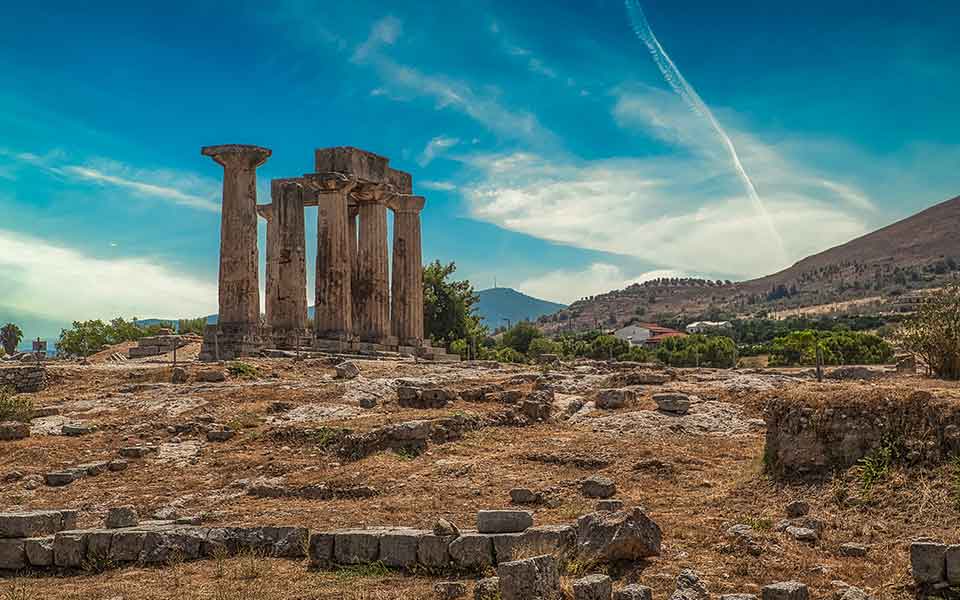
Archaeological Museum of Ancient Corinth
Back on the mainland, the extensive ruins of the ancient city of Corinth form one of the most important (albeit often overlooked) archaeological sites in Greece. Geographically blessed, Corinth grew to be one of the wealthiest and most powerful city-states in the ancient Greek world, controlling the narrow Isthmus that joins the Peloponnese to the rest of the mainland, and a key location on the travels of St. Paul the Apostle in the first century AD.
The recently upgraded Museum, located at the entrance of the archaeological site, is home to a spectacular collection of artifacts from the Geometric Period until the city’s destruction by the Romans in 146 BC. The Museum is organized around two atriums, giving it the feel of an ancient villa. Among its many highlights are twin Archaic-era Kouroi, confiscated in 2010 from antiquity smugglers in the nearby village of Klenia. The statues, made of Parian marble, marked the graves of two young men who were buried sometime between 530 and 520 BC.
The Museum is open throughout the year (closed on Tuesdays from December 10 to April 10). A combined ticket for the Museum and archaeological site is 8 euros.
Ancient Korinthos, 200 07. Tel. (+30) 27410.312.07
Archaeological Museum of Thebes, Viotia
Saving the best for last, the Archaeological Museum of Thebes is hands-down one of the finest museums in Greece. The original museum had been converted from an old military barracks in 1905, housing artifacts from excavations carried out in the modern town, built directly over the site of the ancient city, and the surrounding region of Viotia (Boeotia). Following a complete overhaul and reorganization in 2015, the Museum now employs the latest in audiovisual technology and interactive displays, presenting the full chronological sequence from the Palaeolithic to the foundation of the modern Greek state. Among its many highlights are the famous cylinder seals from the “Treasure Room” of the Mycenaean Palace at Thebes, and the open archaeological site under the Museum, revealing the layers of Bronze Age habitation from the northern edge of the Kadmeia (ancient acropolis), c. 2500-1200 BC.
The central Greek region of Viotia packs in more archaeology per square inch than any other region in the country, home to Mycenaean citadels (Gla, Orchomenos), Classical and Hellenistic theaters, and Frankish fortifications, and features in just about every story from Greek mythology. Thebes itself has been dubbed by scholars as the “forgotten city of ancient Greece,” losing out to the more glamorous Athens and Sparta. Nevertheless, it rose to glory in the early 4th century BC, becoming, albeit briefly, the most powerful city-state in the Greek world.
Today’s city is off the beaten track for most visitors to Greece (one for “completists” perhaps), but for history buffs and archaeology aficionados, it is well worth the trip.
Threpsiadou 1 Keramopoulou Sq, Thebes, 322 00. Tel. (+30) 22620.279.13 / 22620.235.59
The Museum is open year round (closed every Tuesday). General admission is €6.
This article first appeared in Greece Is (www.greece-is.com), a Kathimerini publishing initiative.
